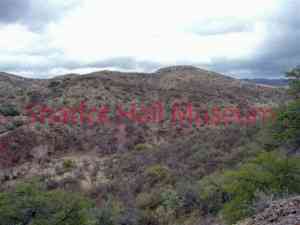By Al Bates
First published Jan 31, 2015 and re-edited in 2019.
In January 1737, Captain Juan Bautista de Anza reported from his outpost in Sonora to his superiors in central Mexico about vast deposits of silver near the “Arizona rancheria” owned by his deputy mayor, Bernardo de Urrea. That discovery, known as the Planchas de Plata, had two results. First was a struggle over ownership of the silver. Second was the adoption of the rancheria’s name to identify the surrounding area.
Captain de Anza, a Spanish Basque, was the Justicia Mayor, or Chief Justice of Sonora, province of New Spain. He was also Capitán Vitalicio, or Captain for Life of the Fronteras Presidio and father of the more famous Juan Bautista de Anza who, in the next generation, led Spanish colonists to San Francisco.
The extensive silver find included a single slab weighing over one hundred arrobas (roughly one and a quarter tons) and sparked an immediate argument. Simply put, if the silver was natural and unprocessed, the finders owned it all—minus the King of Spain’s fifth. If it was “buried treasure” the king owned it all.
 The isolated and unnamed location of the silver find was west of today’s Nogales in modern Sonora, Mexico, and Anza named the site after his patron saint, San Antonio de Padua. Then he rode twelve miles to de Urrea’s house where he spent the next week dictating and signing dispatches and orders and impounding all the silver. Thus, sixteen important documents signed by Anza were written and dated at Bernardo de Urrea’s house in el puesto [place] del Arizona. While the struggle for ownership played out in favor of the discoverers, the name Padua gradually disappeared from correspondence about the find and the name Arizona became prominent.
The isolated and unnamed location of the silver find was west of today’s Nogales in modern Sonora, Mexico, and Anza named the site after his patron saint, San Antonio de Padua. Then he rode twelve miles to de Urrea’s house where he spent the next week dictating and signing dispatches and orders and impounding all the silver. Thus, sixteen important documents signed by Anza were written and dated at Bernardo de Urrea’s house in el puesto [place] del Arizona. While the struggle for ownership played out in favor of the discoverers, the name Padua gradually disappeared from correspondence about the find and the name Arizona became prominent.
So now the question: Where did the name “Arizona,” given to the small group of houses where deputy Urea lived, originate?
Origin of the name “Arizona” has been the topic of speculation and debate for many decades with most attempts placing its origins in the Spanish and/or Pima-Papago languages (today known as the Akimel and Tohono O’odham tribes). Some of the theories include: Arizuma from the Aztec by way of the Spanish; Arizonac and Ali Sonac from the Pimas; Aleh Zone from the Papago; and Zona Arida from the Spanish.
It was not until recent years that a new theory emerged, that the name came from the unique Basque language of northern Spain and southern France. Spanish Basques and their descendants settled in many areas of New Spain, and one example was the de Anza family.
Dr. William A. Douglass of the University of Nevada first proposed the theory, followed by interpretive historian Donald T. Garate who did additional research. Who chose the name for the site of Sr. Urrea’s rancheria is unknown, but Mr. Garate has demonstrated that the name is derived from “the good oak” in the Basque language. He also showed that the common misspelling “Arizonac” came about through a later clerical error.
In Basque, Ariz is oak tree and ona is good. Thus, Arizona means “the good oak tree” and is named for vegetation common to the area. (Adding a terminal “c” pluralizes the name.)
Because of the prominence of the silver find, the name Arizona soon was applied to the nearby area, as well. It remained for the acquisition of the American Southwest following the Mexican War of 1846-48 and the Gadsden Purchase of 1854 for the name to have an even wider definition. By 1856, residents of the Gadsden Purchase area were clamoring to be split from New Mexico as a separate territory named Arizona. In early 1863, that desire was met—although for a much larger area.
Is the discussion of the source of our state’s name over? Probably not, as historians tend to be a disputative lot.
The material in this article is adapted from articles written by the late Donald T. Garate accessed through the Tumacacori National Park website.
“Days Past” is a collaborative project of the Sharlot Hall Museum and the Prescott Corral of Westerners International (www.prescottcorral.org). This and other Days Past articles are also available at https://sharlothallmuseum.org/articles/days-past-articles.l. The public is encouraged to submit proposed articles and inquiries to dayspast@sharlothallmuseum.org. Please contact SHM Library & Archives reference desk at 928-445-3122 Ext. 2, or via email at archivesrequest@sharlothallmuseum.org for information or assistance with photo requests.


